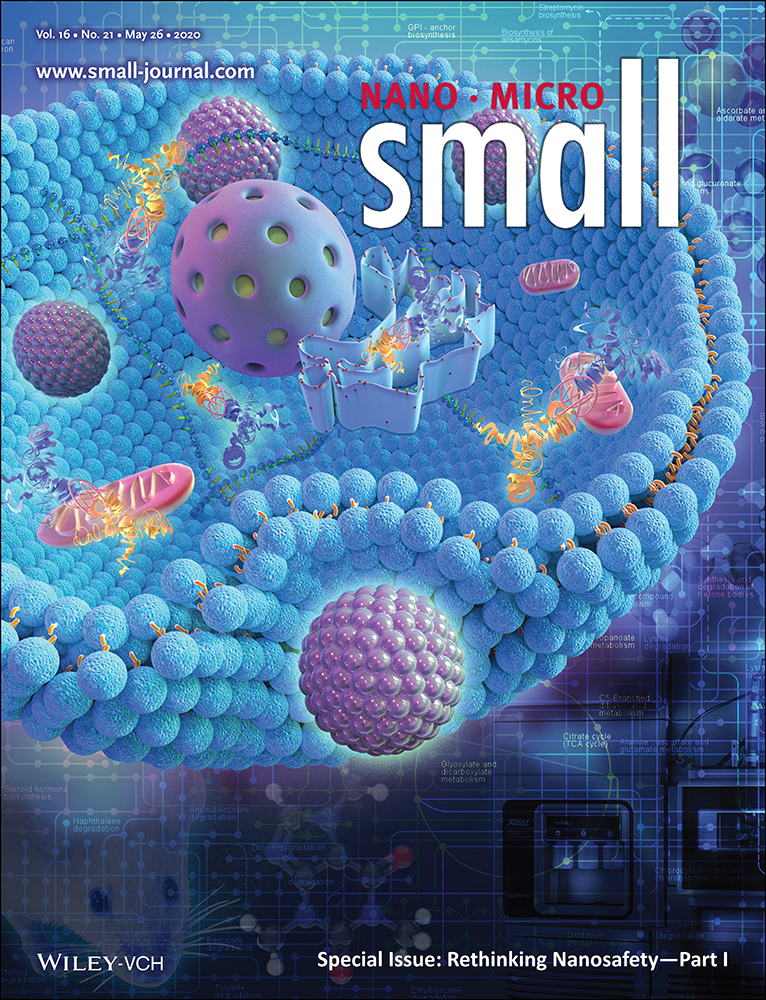Acute Phase Response as a Biological Mechanism-of-Action of (Nano)particle-Induced Cardiovascular Disease
The copyright line for this article was changed on 8 April 2020 after original online publication.
Abstract
Inhaled nanoparticles constitute a potential health hazard due to their size-dependent lung deposition and large surface to mass ratio. Exposure to high levels contributes to the risk of developing respiratory and cardiovascular diseases, as well as of lung cancer. Particle-induced acute phase response may be an important mechanism of action of particle-induced cardiovascular disease. Here, the authors review new important scientific evidence showing causal relationships between inhalation of particle and nanomaterials, induction of acute phase response, and risk of cardiovascular disease. Particle-induced acute phase response provides a means for risk assessment of particle-induced cardiovascular disease and underscores cardiovascular disease as an occupational disease.
1 Introduction
Inhalation of particulate air pollution is associated with mortality and morbidity[1-5] and cardiovascular disease constitutes a major fraction of the particle-induced morbidity.[6] In a famous study by Clancy et al.,[6] the effect of banning coal-heating in private households in Dublin, Ireland in 1991 was followed by comparing mortality rates 6 years before and after the ban. The ban was very efficient as the level of black smoke was reduced by 0.036 mg m−3 (70%). The average mortality rate was reduced by 75 per 100 000 person-years (adjusted for the mortality in the rest of Ireland, where no ban was implemented). Importantly, 77% of the reduced mortality was cardiovascular.
Evidence suggests that inhalation of nanoparticles is more hazardous than inhalation of larger particles with the same chemical composition.[7] This is because nanoparticles possess an ultrahigh surface to mass ratio[8] and have a higher deposition rate in the alveolar region of the lung, where clearance is low.[9] Nanoparticles are consequently removed more slowly from the lung compared to larger particles (at the same air concentration by mass),[10] resulting in prolonged presence of the nanoparticles in the alveolar region of the lung.[10, 11] This leads to long-lasting pulmonary presence of particles with large total surface area. The prolonged presence, in turn, causes inflammation, which is proportional to the total surface area of the deposited particles.[8, 12] We have previously reported that the strongest transcriptional response in lung tissue from mice exposed to TiO2 nanoparticles or carbon nanotubes is a pulmonary acute phase response.[11, 13, 14] Acute phase response activation is a well-known risk factor for cardiovascular disease.[15, 16] In this article, we review a number of recent animal and human studies that strengthen our previously proposed mechanism of particle-induced pulmonary acute phase response as a mechanism of action of particle-related cardiovascular disease.[17]
The acute phase response was originally defined as a group of physiologic, systemic changes induced by infection and tissue injury.[15] Conditions that commonly lead to induction of the acute phase response include infection, trauma, burns, tissue infarction as well as inflammatory diseases and advanced cancer.[15] Acute phase proteins are defined as serum proteins whose plasma levels increase or decrease by at least 25% during an inflammatory disorder. Gabay and Kushner listed 39 different human acute phase proteins including members of the complement system, proteins involved in coagulation and fibrinolysis, antiproteases, transport proteins, and inflammatory mediators.[15] Serum Amyloid A (SAA) and C-reactive protein (CRP) are the most dynamically regulated acute phase proteins and can be upregulated more than 1000-fold during an acute phase response.[15] Humans have two inducible SAA isoforms, SAA1 and SAA2, whereas mice express three isoforms, Saa1, Saa2, and Saa3.[18] Interestingly, rats do not express Saa genes, whereas Crp is only moderately inducible in mice.[19]
Both SAA and CRP are risk factors for coronary heart disease in prospective, epidemiological studies.[20] In the Nurses' Health Study, SAA and CRP levels at baseline were predictive of increased risk for cardiovascular events defined as death from coronary heart disease, nonfatal myocardial infarction or stroke, or the need for coronary-revascularization procedures. A fivefold increase in the levels of SAA was associated with threefold increased risk of cardiovascular events.[20] Serum levels of CRP and SAA are highly correlated in humans.[21-23] However, CRP is likely not causally related to risk of cardiovascular disease, since genetic variation in CRP are associated with variations in blood levels of CRP but not with risk of coronary heart disease.[24-26] This suggests that CRP is not causally related to cardiovascular disease, but co-vary with the causal factor, which could be SAA.
2 Proposed Mechanism of Action: Serum Amyloid A Directly Promotes Atherosclerosis
SAA are pleiotropic proteins that also have cytokine-like pro-inflammatory activities and can signal through several cell surface receptors including TLR2, TLR4, CD36, FPR2, RAGE, and P2XY.[27] Under sterile conditions, SAA can stimulate the NLRP3 inflammasome of phagocytes to produce high levels of TNFα, IL1a, IL1b, and IL6, important cytokines of the acute phase response.[28] During the acute phase response, SAA becomes incorporated into high-density lipoproteins (HDL), thereby replacing Apolipoprotein A-1 especially at high SAA concentrations.[18, 29] An activated acute phase response inhibits reverse cholesterol transport in humans and mice.[30, 31] Reverse cholesterol transport is a major anti-atherogenic activity of HDL, where HDL removes excess cholesterol from peripheral cells and transports the cholesterol back to the liver for subsequent excretion into bile and feces.[30] The SAA-mediated inhibition of reverse cholesterol transport results in increased cholesterol sequestering in peripheral cells including macrophages, turning them into foam cells.[32]
SAA has been shown to be causally implicated in atherosclerosis. Inactivation of all three SAA isoforms decreases atherosclerosis in ApoE –/– mice,[33] a commonly used mouse model of atherosclerosis, whereas overexpression of Saa1[34, 35] and Saa3[33] increases atherosclerosis in ApoE –/– mice. This shows that SAA expression is implicated in the formation of plaques in ApoE –/– mice. Inactivation of only Saa1 and Saa2 did not affect the basal level of atherosclerosis,[36] indicating that the three isoforms have overlapping functions and are likely all pro-atherogenic.
Thus, SAA inhibits reverse cholesterol transport and stimulates macrophage foam cell formation, and promotes plaque formation and thereby atherosclerosis.
3 Particle-Induced Acute Phase Response
The clinical manifestation of acute phase response includes fever, leukocytosis, increased vascular permeability and increased serum levels of acute phase proteins. However, the proteins in systemic circulation can originate from various organs and the organ of production can only be identified by increased levels of transcription of acute phase response genes in organ tissue or specific cells.
The acute phase response following inhalation of particles initiates at the transcriptional level in the lung. Inhalation exposure to TiO2 nanoparticle for 1 h daily for 11 days induced pulmonary acute phase response but no hepatic acute phase response 5 days after last exposure day.[11] In the lung tissue, global transcriptional profiling showed that the acute phase gene Saa3 was the most differentially regulated gene,[11, 37] but Saa3, Saa1, and Saa2 were all highly expressed in lung tissue following pulmonary exposure to TiO2 and carbon black nanoparticles as well as multiwalled carbon nanotubes.[13, 17, 38] Pulmonary Saa3 mRNA expression has been shown to correlate with blood levels of SAA3 following pulmonary exposure to carbon nanotubes[39] and pulmonary Saa3 expression was paralleled by increased blood levels of SAA3 following pulmonary exposure to carbon black, diesel exhaust particles, jet engine particles, and nanofibrillated cellulose.[38, 40-42] It has been a central dogma that acute phase response proteins are primarily synthesized in the liver.[18, 29] However, no hepatic acute phase response was detected in mice following inhalation exposure to 20 mg m−3 of Printex 90 carbon black nanoparticles or NIST2975 diesel exhaust particles for 90 min a day, for 4 consecutive days.[43] Instead, inhalation of carbon black and diesel exhaust particles induced a pulmonary acute phase response,[17, 44] which for carbon was already detected after 24 h at concentrations of 380 µg m−3.[37]
Hepatic acute phase response has been detected 1 day after pulmonary exposure to multiwalled carbon nanotubes, but the acute phase response had diminished on day 3 post-exposure, in contrast to pulmonary Saa3 levels that remained elevated.[45] Saa1 was the most differentially expressed hepatic acute phase response following airway exposure to TiO2[46] and carbon nanotubes[39, 47, 48] and we use Saa1 mRNA levels as a biomarker of the hepatic acute phase response.[45] Pulmonary Saa3 mRNA expression levels were greater and lasted longer than hepatic Saa1 mRNA expression,[45] again suggesting that following pulmonary exposure, the pulmonary acute phase response is stronger and more long lasting than the hepatic acute phase response.
4 Physico-Chemical Predictors of Particle-Induced Acute Phase Response
SAA is a macrophage and neutrophil chemoattractant[49] and Saa mRNA levels in lung tissue correlates closely with neutrophil cell numbers in bronchoalveolar lavage fluid across particle type, dose level, time point and pulmonary dosing method (inhalation or instillation) in mice.[17, 37, 44, 45, 50] Particle-induced pulmonary inflammation in terms of neutrophil influx has been shown to correlate closely with total surface area of the deposited particles.[8, 12, 51] Similarly, Saa3 mRNA levels (and hence acute phase response) correlate with the total surface area of the deposited nanoparticles and carbon nanotubes.[17, 45] In addition, plasma levels of SAA3 have been shown to correlate with Saa3 mRNA levels in lung tissue[13] and with neutrophil cell numbers in broncho-alveolar lavage fluid in mice exposed to multiwalled carbon nanotubes,[45] suggesting that SAA3 protein in plasma originates from the lung. This suggests that pulmonary transcription levels of acute phase response genes can be predicted by the deposited surface area of insoluble particles. Since the specific surface area of particle increases with decreasing particle size, the pulmonary acute phase response may be predicted based on estimation of the particle deposition and retention in the alveolar region.
There is evidence suggesting that some types of inhalable materials induce much stronger acute phase response than predicted by the total deposited surface area. These include nano-fibrillated cellulose,[42] graphene oxide[41] and soluble metal oxides such as ZnO.[52] Graphene oxide and nano-fibrillated cellulose are highly hydroxylated on the surface and therefore share structural similarities with lipopolysaccharide (LPS) a potent inducer of acute phase response,[53] and we have previously suggested that this may be the reason for the stronger acute phase response.[41, 42] ZnO undergoes dissolution at the low pH in the lyzosomes, causing cytotoxicity in vivo and in vitro,[52, 54] and this is a likely cause of the strong ZnO-induced acute phase response.
5 Dose-Dependent, Particle-Induced Pulmonary Acute Phase Response
We have consistently found that pulmonary exposure to nanomaterials by inhalation or by instillation induces a pulmonary acute phase response. The pulmonary acute phase response is dose-dependent, both in terms of the number of differentially regulated acute phase genes and in terms of the fold increase in the mRNA expression level of the most differentially regulated acute phase gene, Saa3.[17] The acute phase response is long lasting, as increased levels of Saa3 mRNA in lung tissue and SAA3 in plasma were detected 28 days after exposure to multiwalled carbon nanotubes[13, 39, 45] and increased Saa3 mRNA levels in lung tissue were detected 90 days after exposure to Printex90 carbon black nanoparticles.[41] We have used mRNA levels of Saa3 as biomarker of the pulmonary acute phase response.[44] Dose-dependent pulmonary acute phase response has been reported for many different nanoparticles and dusts including TiO2 particles,[14, 17, 55-58] carbon black,[38] carbon nanotubes,[13, 44, 45, 59] combustion particles,[40, 44, 60] graphene oxide and reduce graphene oxide,[41] nano-fibrillated celluloses,[42] ZnO nanoparticles,[52] halloysite nanotubes[61] and sanding dust from paint and epoxy composites.[58, 62] Figure 1 shows a heat map of the gene expression levels of 26 acute phase proteins following pulmonary exposure to different insoluble nanomaterials and asbestos. The list of genes were derived using supervised statistical analysis of gene expression data and the level of inflammation assessed by the percentage of neutrophils in the bronchoalveolar lavage fluid. The heat map shows the nanoparticles on the horizontal axis ordered according to the percentage of neutrophils and the acute phase response genes are listed on the vertical axis according to a score for how their expression correlates with neutrophil levels. The 26 acute phase proteins are briefly described in Table 1.
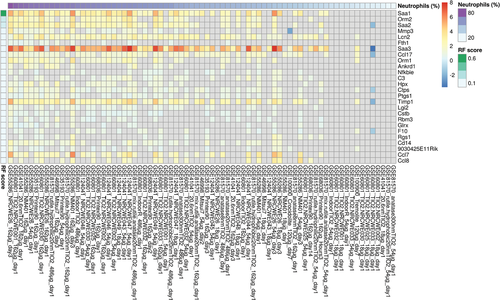
| Gene symbol | RF score | Gene name and function |
|---|---|---|
| Saa1 | 0.6824159478 | Serum Amyloid A1. Major acute phase protein |
| Orm2 | 0.1241813132 | Orosomucoid 2. Major acute phase protein |
| Saa2 | 0.0971252625 | Serum Amyloid A2. Major acute phase protein |
| Mmp3 | 0.0154310491 | Matrix Metallopeptidase 3. The protein promotes neutrophil infiltration into the lung and plays an important role in acute inflammatory response |
| Lcn2 | 0.0120446052 | Lipocalin 2. Iron-trafficking protein, acute kidney injury biomarker |
| Fth1 | 0.0115027576 | Ferritin Heavy Chain 1. The protein mediates iron homeostasis |
| Saa3 | 0.0094597367 | Serum Amyloid A3. Major acute phase protein |
| Ccl17 | 0.0077724584 | Chemokine (CC motif) ligand 17. Th2 CC chemokine ligand |
| Orm1 | 0.0075323055 | Orosomucoid 1. Major acute phase protein |
| Ankrd1 | 0.0049984728 | Ankyrin Repeat Domain 1. Ankrd1 is a transcription factor involved in regulation of downstream signaling of pattern recognition receptors |
| Nfkbie | 0.0041863373 | NFKB Inhibitor Epsilon. Inhibitor of NF-kappa-B signaling |
| C3 | 0.0040131412 | Complement C3. Component of the complement system |
| Hpx | 0.0034413209 | Hemopexin. Major acute phase protein, mediates heme and iron homeostasis |
| Ctps | 0.0025481592 | CTP Synthase 1. Ctps induces proliferation of activated lymphocytes |
| Ptgs1 | 0.0025139002 | Prostaglandin-Endoperoxide Synthase 1, Cyclooxygenase-1 (COX-1). Inflammatory lipid mediator |
| Timp1 | 0.0020899172 | TIMP Metallopeptidase Inhibitor 1. Timp1 regulates matrix metalloproteinases |
| Lgi2 | 0.0014406552 | Leucine Rich Repeat LGI Family Member 2 |
| Cstb | 0.0013009519 | Cystatin B. Protection against lysosomal protease leakage |
| Rbm3 | 0.0011968426 | RNA Binding Motif Protein 3 |
| Glrx | 0.0011255511 | Glutaredoxin. The protein is considered as a sensor of oxidative stress mediated by H2O2. |
| F10 | 0.0010072173 | Coagulation Factor X |
| Rgs1 | 0.0009115299 | Regulator of G Protein Signaling 1 |
| Cd14 | 0.0005990058 | CD14 Molecule. The protein encoded by this gene is a surface antigen that is mainly expressed on monocytes/macrophages |
| 9030425E11Rik | 0.0004969364 | Clmp, CXADR-like membrane protein. Cell-cell adhesion protein |
| Ccl7 | 0.0003589204 | CC Motif Chemokine Ligand 7. Ccl7 modulates acute neutrophilic lung inflammation |
| Ccl8 | 0.0003057048 | CC Motif Chemokine Ligand 8. Chemotactic factor that attracts lymphocytes, monocytes, eosinophils, and basophils |
- RF score is the value of the feature importance derived from random forest regression classifier.
Occupational exposure to various metal oxides including ZnO and CuO is known to induce metal fume fever in exposed workers.[66, 67] In a controlled study of 16 healthy volunteers, Christian Monsé et al.[68] demonstrated that inhalation of nanosized ZnO particles induces dose-dependent acute phase response in humans (Figure 2). The volunteers were exposed to 0, 0.5, 1, and 2 mg m−3 ZnO nanoparticles for 4 h on different days separated by 2 weeks. One day after exposure, CRP was statistically significantly increased at 2 mg m−3, and SAA levels were statistically significantly increased in a dose-dependent manner at 1 and 2 mg m−3 whereas 0.5 mg m−3 was identified as a no-effect-level (Figure 2). Notably, these exposure levels are well below current occupational exposure levels for ZnO (5 mg m−3 ZnO or 4 mg m−3 Zn), calling for re-evaluation of the occupational exposure limit.[69] Pulmonary exposure to ZnO nanoparticles in mice induced dose-dependent pulmonary acute phase response with similar no-effect-levels,[52] suggesting that studies in mice can be used for risk assessment of particle-induced acute phase response.
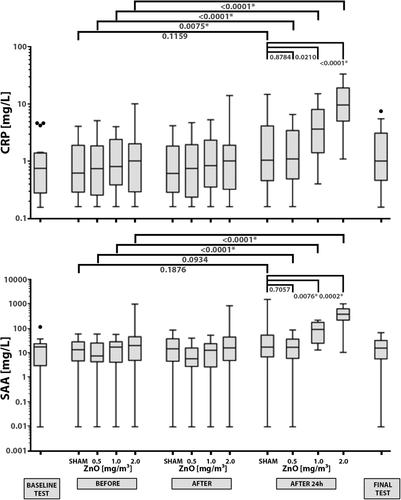
6 Biomonitoring Studies of Occupational Exposure to Particles and Dust
There are a limited number of occupational biomonitoring studies which included assessment of exposures to (nano)particles and dusts and measurements of SAA or CRP (Table 2). As can be seen from the studies, exposure to welding particles was consistently accompanied by increased blood levels of acute phase response proteins with the exception of metal inert gas (MIG) welding with aluminium.[70-76] This is consistent with the strong dose-response relationship observed following inhalation of ZnO nanoparticles.[68] Correlation between dust levels during steel production and iron foundry and blood levels of CRP or SAA have been observed.[77, 78] Interestingly, dust from paper production also induced a strong acute phase response in workers following occupational exposure,[79] paralleled by a strong acute phase response in mice exposed to nano-fibrilliated cellulose.[42] For occupational exposure to combustion particles, both positive and negative studies were identified.[22, 50, 80-83] Taken together, occupational biomonitoring studies report increased blood levels of acute phase response proteins among workers following occupational exposure to particles especially in controlled studies, where the participants serve as their own control. In other studies, including cross-sectional studies, positive correlations between exposure to particles and acute phase response proteins CRP and SAA were found.
| Population investigated | Exposure (description of) | Effect on CRP in the circulation | Effect on SAA in the circulation | Reference |
|---|---|---|---|---|
| Zinc oxide nanoparticles | ||||
| Volunteers in exposure unit, Women (n = 8) and men (n = 8) | Inhalation of nano-sized zinc oxide particles at levels: 0.016, 0.514, 1.013, and 2.014 mg m−3, each for 4 h with 2 weeks' intervals. Blood samples were taken as a baseline test two to 6 weeks earlier, during the experimental periods and as a final test two to 6 weeks afterwards | Increased CRP at 1 and 2 mg m−3 24 h after exposure | Increased SAA at 1 and 2 mg m−3 24 h after exposure | [68] |
| Welding fumes | ||||
| Volunteers in emission room, Men (n = 15) | Welding fume particles at 2.5 mg m−3 (Aluminium-bronze wire), 6 h of exposure | (increased nasal CRP as a measure of systemic CRP) | (increased nasal SAA as a measure of systemic SAA) | [70] |
| Volunteers in emission room, Men (n = 15) | Air or three welding fume scenarios 6 h on four different study days with 1 week in-between. Scenario 1 contained Zinc-zinc (2 mg m−3), Scenario 2: Zinc-aluminium (2 mg m−3); Scenario 3: Aluminium-bronze (2.5 mg m−3) | Increased CRP at 29 h after exposure (all scenarios) | Increased SAA at 29 h after exposure (all scenarios) | [72] |
| Volunteers in emission room, Men (n = 15) | Welding fumes. Threefold cross-over with day 1 fume: Zinc only (11.5 mg m−3), At another day: copper only (0.4 mg m−3) and on the last day: Zinc and copper (1.5 plus 0.4 mg m−3), Each exposure lasted 6 h and had 1 week in-between | Increased CRP at 24 h after exposure (for all types of fume) (published in Markert et al. | Increased SAA at 24 h after exposure (for all types of fume) | [71] And for CRP:[84] |
Welders monitored at a welding school (USA), Men (n = 24) |
Welders were exposed to 1.66 mg m−3 for 5.3 h, blood samples were collected at baseline and 16 h after exposure | CRP was increased after exposure | n/a | [73] |
| Volunteers in emission room, Men (n = 12) | Fumes from metal inert gas (MIG) welding of aluminium (2.5 mg m−3), or fumes from MIG soldering of zinc coated materials using a copper containing welding wire (2.5 mg m−3), In a three-fold cross over design with 1 week in-between each exposure (6 h). | After MIG soldering CRP was increased, MIG welding of aluminium: No effect on CRP | n/a | [74] |
| Volunteers in emission chamber, Men (n = 12) | MIG brazing fumes on three different exposure days (6 h), 1 week in-between each exposure, blood samples drawn before and 24 h after exposure. Each exposure was part of a stepwise decrease or increase in zinc concentration starting with 0.9 mg zinc m−3, 1.43 mg PM10 m−3) | CRP was increased after exposure to fumes with 1.2 and 1.5 mg m−3 zinc. No effect was observed at 0.90 mg m zinc | n/a | [75] |
| Welders at work (Sweden), Men (n = 101) | A cross sectional study of 101 welders and 127 controls. Welding fumes were measured as respirable dust. Welders were exposed to a median of 1.1 mg m−3. The level among controls was lower than 0.1 mg m−3 | No correlation between exposure and CRP | SAA was positively associated with exposure to respirable dust |
[76] |
| Dust from paper production | ||||
| Workers in a pulp and paper mill at work (Sweden), Women (n = 10) and men (n = 62) | Dust while working at the mill. Personal sampling: 8-h-time-weighed average of 0.3 mg m−3 with the highest exposure in the mixing department (3.3 mg m−3) | Relation observed between CRP and exposure metrics: PM10, total, and inhalable dust | Relation observed between SAA and exposure metrics: PM10, total, and inhalable dust | [79] |
| Emissions from steel/iron manufacturing | ||||
| Steel-production plant workers at work (Italy), Men (n = 37) | PM1 and PM10 (coarse PM) measured in 11 different working areas. PM1 mean level: 0.008 mg m−3; PM10 mean level: 0.262 mg m−3. Blood samples taken on the first and fourth day of a working week | Both PM1 and PM10 exposure was associated with increased CRP | n/a | [78] |
Iron-foundry workers at work (Sweden), Women (n = 5) and men (n = 80) |
Average 8-h time-weighted average air concentrations of respirable dust and quartz were 0.85 and 0.052 mg m−3, respectively. Aerosol and blood samples were taken on the second or third day after a work free weekend. Blood sampling was repeated 2 days after the first sampling | No correlation between exposure and CRP | Relation observed between SAA and exposure metrics: PM1, PM10, and inhalable dust | [77] |
| Emissions from highway maintenance | ||||
| Highway maintenance workers at work (Switzerland), Men (n = 18) | PM2.5, and ultrafine particles during as many as five 24-h-periods. PM2.5 had a mean level of 0.056 mg m−3 and ultrafine particles 0.112 mg cm−3 | Association between PM2.5 and CRP | Association between PM2.5 and SAA | [82] |
| Emissions from diesel engines | ||||
| Volunteers sitting as passengers in diesel or electric trains; Women (n = 15) and men (n = 14) | Sitting as passengers in a diesel train and there being exposed to carbon black at 10.5 µg m−3 and PM2.5 at 0.068 ± 0.032 mg m−3, as compared to sitting as passengers in an electric train and there being exposed to only: carbon black at 1.8 µg m−3 and PM2.5 at 0.032 ± 0.007 mg m−3 | No effect on CRP | No effect on SAA | [80] And [85] |
| Coke-oven emissions | ||||
| Coke-oven workers monitored at one time point (Poland), Men (n = 87) | Exposed to coke oven emissions and 1-hydroxypyrene measured as a marker of PAH exposure | 1-hydroxypyrene (a marker for PAH exposure) was a predictor of CRP | 1-hydroxypyrene (a marker for PAH exposure) was a predictor of SAA | [22] |
| Emissions from firefighting | ||||
| Wildland firefighters at work (United States Forest Service-Savannah River), Sex not reported (n = 10) | Smoke (personal monitoring of PM2.5 and CO) during burning season (January to March) | Firefighters lighting with drip-torches had higher cross-work-shift increases in CRP, as compared to firefighters holding a task involving management of fire boundaries |
Firefighters lighting with drip-torches had higher cross-work-shift increases in SAA, as compared to firefighters holding a task involving management of fire boundaries |
[83] |
| Volunteers participating in a firefighting training course, Women (n = 12) and men (n = 41) | Exposure was a 3-day fire-fighting training course | No effect on CRP | No effect on SAA | [50] |
| Firefighters at work, Men (n = 22) | Measured before and after a 24-h work shift. | No effect on CRP in workers reporting to be involved in fire extinction activities (n = 14) | No effect on SAA in workers reporting to be involved in fire extinction activities (n = 14) | [81] |
- MIG, metal inert gas; PAH, polycyclic aromatic hydrocarbon.
Taken together, the biomonitoring studies strongly suggest that occupational exposure to dust and particles leads to increased systemic acute phase response. The studies in mice furthermore suggest that the particle-induced acute phase response is long lasting for insoluble particles, which in occupational settings with re-occurring exposures would translate to a 45-year work-life. Since even very small increments in CRP and SAA levels are associated with significantly increase future risk of coronary heart disease in prospective studies, the observed correlations between occupational exposure to metal oxide particles and increased acute phase response warrants reassessment of occupational exposure to metal oxides and other exposures that entail induction of acute phase response.
7 Serum Amyloid A and C-Reactive Protein as Biomarkers of Particle Exposure
CRP is routinely used in the clinical practice as a biomarker of systemic inflammation,[86] and sensitive and reliable assays for detection of CRP and SAA are commercially available.[21] However, both SAA and CRP levels are influenced by many different factors including body mass index, smoking status, chronic inflammatory diseases, use of anti-inflammatory medicine and bacterial and viral infections.[15, 22, 23] Both bacterial infections leading to short-term large increases in blood levels of CRP and SAA, and long-term low-inflammatory conditions leading to small increases are associated with risk of cardiovascular disease.[86, 87] While bacterial infections increase CRP and SAA levels by more than 1000-fold,[15] inhalation of occupationally relevant doses of ZnO increased CRP and SAA levels by a factor of 10,[68] and the effect of inhaled insoluble particles such as air pollution appears to be even smaller. Thus, in a study of the association between air pollution levels modelled from satellite-images and CRP levels in 30 034 participants, 5 µg m−3 PM2.5 increments were associated with 1.31% increase in CRP [95% confidence interval (CI): 1.00%, 1.63%) after adjusting for confounders.[88] Such small increments are often difficult to detect even in occupational biomonitoring studies[50, 80, 89] because large inter-individual variation in basal levels of CRP and SAA hampers the statistical power to detect exposure-related effects.[23] However, the inter-individual variation may be controlled for by adjusting SAA levels for CRP, thus using CRP as a biomarker of the individual baseline level of acute phase response.[22, 23]
8 Cells Expressing Acute Phase Response Proteins in the Lung
For hazard and risk assessment purposes, specific test protocols and assays need to be developed. Sub-chronic and chronic inhalation studies for assessing lung cancer risk are usually performed in rats,[90] but rats may be an inappropriate model for assessment of particle-induced acute phase response in humans since rats do not express SAA. In addition, in vitro assays and high-throughput assays are preferred both from an animal welfare perspective and for economic reasons.
A body of studies shows particle-induced induction of acute phase response in terms of increased Saa3 transcription and SAA3 release.[13, 14, 39, 40, 42, 45, 46, 52, 91-96] Furthermore, Saa3 mRNA levels were increased within a few hours and SAA3 protein was measured by ELISA as early as 6 h after LPS instillation accumulating up to 24 h before slowly declining to base levels over a course of days.[97] (unpublished data) However, all these studies were conducted in bronchoalveolar lavage or whole lung tissue, and the responsible cell types have not yet been identified. Early studies using models of endotoxin (LPS) triggered inflammation mainly suggested macrophages as the origin of extrahepatic Saa expression.[98] However, several different cell types in human lung are capable of expressing SAA including macrophages, epithelial cells and fibroblasts.[99] Thus, all three cell types expressed C-reactive protein (CRP), SAA1, SAA2, and SAA4. Transcript levels of CRP and SAA1 were highest in epithelial cells, whereas SAA2 and SAA4 transcript levels were highest in fibroblasts. However, particle-induced SAA transcription has not yet been shown in human lung tissue.
Recent single-cell RNA sequencing data from murine lung tissue showed strong carbon nanoparticle-induced Saa3 transcription almost exclusively in mesenchymal cells, a cluster including fibroblasts and activated mesothelial cells, and to a much lesser extent in alveolar type 2 cells (Figure 3). Importantly, the cellular signature was hugely different for LPS exposed mice in the single cell data set. Here, mainly leukocytes, in particular dendritic cells/interstitial macrophages, granulocytes and recruited monocytes were responsible for induced Saa3 expression (Figure 3). These preliminary data demonstrate that under aseptic conditions like sterile particle-induced inflammation, the acute phase response can be executed by resident stromal cells. In this context, inflammatory stimulation of rabbit synovial fibroblasts was shown to trigger Saa3 expression[100] and inflammatory stimulation of human epidermal keratinocytes and dermal fibroblasts induced Saa1 and -2.[101] An important role of stromal-derived Saa3 has also been described for cancer-associated fibroblasts, where SAA3 stimulated adenocarcinoma growth in a pancreatic cancer mouse model.[102]
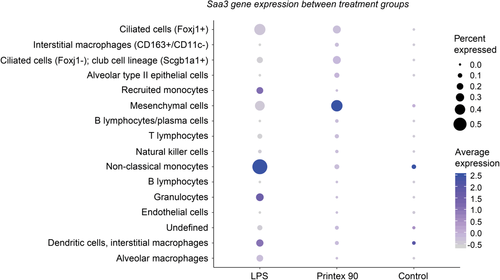
Saa3 is the most differentially expressed acute phase response gene upon particle exposure in vivo and moreover causally implicated in atherosclerosis, and is therefore the obvious candidate for an acute phase biomarker in in vitro assays. However, its induction could so far not be reproduced in vitro with various models of alveolar epithelial cells or macrophages or their co-culture. LPS however, effectively stimulated the expression of Saa3 in cultured alveolar macrophages and bone marrow derived macrophages (Ana1), matching the in vivo results after LPS stimulation, again demonstrating that different cell types in the lung are required for the responses to specific inflammatory stimuli.[104] Current single cell RNA sequencing experiments from lungs of mice exposed to different nanomaterials shall shed light whether the cell type in which Saa3 is induced depends on the physical chemical characteristics of the nanomaterials.
9 Conclusion and Perspectives
Inhalation of particles is associated with morbidity and mortality and cardiovascular disease accounts for a large fraction of the particle-induced morbidity and mortality.
There is mounting evidence that inhalation of particles induces acute phase response which provides a causal link to risk of cardiovascular disease. The proposed mechanism outlined in Figure 4 has been submitted as an Adverse Outcome Pathway (AOP 237) in the aopwiki.org. The fact that the acute phase response can be predicted by the deposited surface area of insoluble materials has important implications, since the particle-induced acute phase response is a means to predict the cardiovascular risk associated with changes of primary particle size. The same information can also be used to guide safe-by-design decisions.
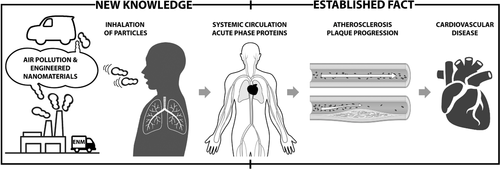
Epidemiological studies show that even small increases in SAA levels are associated with increased risk of cardiovascular disease and occupational studies show positive correlations between exposure to different types of particles and dusts and CRP and SAA as shown in Table 2. The identification of mesenchymal cells as the candidate cell type for particle-induced Saa3 expression contributes to a first step towards the establishment of an in vitro assay for particle-induced acute phase response.
In conclusion, particle-induced acute phase response provides a means for risk assessment of particle-induced cardiovascular disease, and underscores cardiovascular disease as an occupational disease.
Acknowledgements
This work was supported by Danish Centre for Nanosafety 2, and the EU Horizon 2020 project SmartNanoTox, grant agreement no. 686098.
Conflict of Interest
The authors declare no conflict of interest.
Biographies

Tobias Stoeger is a group leader at the Helmholtz Zentrum München-German Research Center for Environmental Health. His research is focused on the toxicity of nanoparticles and alveolar mechanisms of sterile, pulmonary inflammation. Tobias has co-authored over 90 scientific articles.

Anne Thoustrup Saber is senior researcher at the National Research Centre for the Working Environment and PI of past and present national studies related to nanosafety. She has also been participant in EU projects related to nanosafety. She is trained as chemical engineer and human biologist. She has worked with the toxicology of particles since 2000. She has been the Danish member of the Nordic Expert Group for Criteria Documentation of Health Risks from Chemicals (NEG) since 2008.

Ulla Vogel is group leader at the National Research Centre for the Working Environment, PI of Danish Centre for Nanosafety 1 and 2 (2012–2019) and participant in past and present H2020 projects related to nanosafety. She is trained as biochemist, molecular biologist and certified ERT toxicologist. She has worked with molecular epidemiology and the toxicology of inhaled aerosols including nanoparticles with focus on effects in lungs and secondary target organs (cardiovascular, liver, blood) since 1997. She is advisor to the Danish Working Environment Authority on toxicology.



